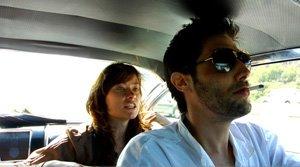Fix

How much of filmmaking is documentary? Even when an actor is performing onscreen, we can sometimes still see traces of the real person underneath the character. And when a camera is turned on us—at a wedding reception or for a home video—we instantly become performers ourselves. If a small city is constructed for a film set, does that make it any less real than a city that already exists?
Though most certainly a narrative film, Tao Ruspoli’s Fix blends fiction with reality to such a degree that at the end, I was left wondering what I had just seen. The story follows Bella (House's Olivia Wilde) and Milo (Ruspoli), a young couple on a road trip to bring Milo’s brother Leo (Shawn Andrews) to a rehab center in L.A. to kick his heroin addiction. An aspiring documentarian, Milo brings his camera along for the ride, capturing their whirlwind tour of southern California with gritty spontaneity.
When the director is also a character, and the film itself a plot point, the line between what’s real and what’s being performed begins to blur. Milo’s camera provides us with rare insight into the facades the three characters put on for each other; for all that Milo lauds his brother in front of Bella, we see him immediately turn resentful whenever she leaves the two of them alone. And some of the most interesting moments of the film occur when a character asks Milo to turn off the camera and he agrees but doesn’t actually comply. Although this often means we can no longer see the character’s face, we can hear them dispel all pretenses just from the sound of their voice.
A great deal of credit must go to the actors for their layered but understated performances. Wilde is particularly effective as the doting but still very independent girlfriend, who starts the film wary of Leo and quickly ends up enchanted by him. It is wonderful to watch her let down her guard and allow herself to be wooed by his recklessness, all in the course of a single day.
Unfortunately, some of the editing ends up detracting from these subtly complex performances. Between the jump cuts and often intentionally nauseating camerawork, Ruspoli’s style is not only distracting but also unoriginal (see The Blair Witch Project and basically any film made with a handheld thereafter). Fix would have been much more compelling if Ruspoli had kept with the style of a true home video and allowed all of the scenes to play out continuously in simple straight-on shots. Instead, the film can sometimes feel over-produced. Still, Fix maintains the meandering, impulsive quality of certain road movies of the seventies, while also managing to keep a brisk pace.